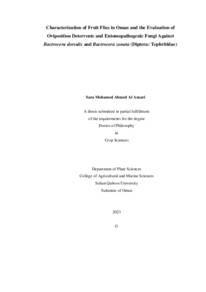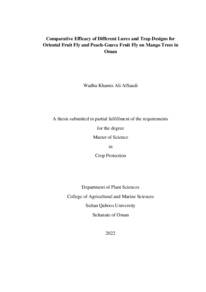Document
Characterization of fruit flies in Oman and the evaluation of oviposition deterrents and entomopathogenic fungi against bactrocera dorsalis and bactrocera zonata (Diptera: Tephritidae).
Other titles
توصيف ذباب الثمار في سلطنة عمان وتقييم مواد رادعة لوضع البيض وفطريات ممرضة للحشرات ضد نوعي dorsalis Bactrocera و zonata Bactrocera( رتبة ثنائية األجنحة: عائلة ذباب الثمار(
Publisher
Sultan Qaboos University.
Gregorian
2023
Language
English
Subject
English abstract
Fruit flies are important pests of fruit and vegetable crops. They cause significant
economic losses to farmers. The objectives of this study were to characterize the fruit
fly species present in Oman, their geographical distribution, host plants, and
parasitoids, and to evaluate the effect of plant extracts and entomopathogenic fungi
against Bactrocera dorsalis and B. zonata. Fruit samples were collected from different
locations across Oman during 2019 and 2020. Fruit flies that emerged from fruits were
then identified using morphological and molecular characterization methods. Results
showed that there were eight fruit fly species in Oman. The polyphagous Bactrocera
dorsalis and Bactrocera zonata were collected from fruits of different trees, while
Dacus ciliatus was collected from cucurbit fruits. Carpomyia vesuviana and
Carpomyia incompleta were collected from fruits of Ziziphus species. Dacus persicus
was collected from the wild plant, Calotropis procera (Sodom's apple). Bactrocera
oleae was collected from fruits of the wild olive (Olea europea) in Al-Jabal Al
Akhdhar Wilayat. Capparimyia savastani was collected from flower buds of wild
Capparis cartilaginea (relative of caper). The most widely distributed fruit flies were
B. zonata and D. ciliatus, however, there were variation in the presence and abundance
of B. zonata and B. dorsalis in different locations. In Musandam and Al Batinah North
only B. zonata was present and this species was more dominant in Al Mudaibi (Al
Rowdah), Al Awabi (Al Alia), Yanqul (Al Buwairdeh) and Al Jabal Al Akhdar (Seeq).
B. dorsalis was found to be more dominant in Salalah (Al Baleed, AdDahareez), Al
Kamil & Al Wafi (Saiq), Qurayat (Hail Al Ghaf) and Samail (Wadi Samail). Molecular
fingerprinting allowed the correct identification of Dacus persicus, as specimens from
Oman were previously known in error as D. longistylus, a closely related species found
in Africa. Braconid parasitoids collected from sampled fruits included Fopius arisanus
from Ziziphus spp., Psyttalia concolor from cucurbits and Ziziphus spp., and
Diachasmimorpha longicaudata from Indian almond. Numerically, these parasitic
wasps were mainly associated with B. zonata, C. vesuviana and C. incompleta on
Ziziphus fruits. Different local plant extracts and commercial substances of plant origin
were tested as oviposition deterrents against B. zonata and B. dorsalis. Two different
methods were used to determine the deterrent effect of the extracts, the first one using
fresh fruits and counting the resulting puparia numbers, and the second using mango
domes and counting the egg numbers in each dome. Neem, linalool, and extracts of
frankincense resin, juniper, and fresh garlic showed good oviposition deterrence
effects under laboratory conditions. Neem showed significant deterrent effect at a
concentration of 0.003%. Fresh garlic and linalool caused reduction in puparia
numbers reaching 80.7% and 86.2%, while frankincense at 100% and 50%
concentrations, and juniper caused reduction in eggs numbers reaching 61.1%, 31.0%
and 59.1% respectively. The effects of entomopathogenic fungi were tested against
adults and larvae of B. zonata under laboratory conditions. Among the
entomopathogenic fungi used, Beauveria bassiana fungal spores in the Botanigard
formulation was effective on adults, causing 97.5% mortality due to direct application
to both adults and caging container, and 88% mortality due to indirect application (on
cage walls only). The same material was also effective on the larvae, causing 28%
mortality. The T Stanes Verticillium lecanii formulation caused 20% and 6.67%
mortality on larvae and puparia respectively.
Member of
Resource URL
Arabic abstract
يعتبر ذباب الثمار من آفات محاصيل الفاكهة والخضروات المهمة، والتي تسبب خسائر اقتصادية كبيرة للمزارعين. هدفت هذه الدراسة إلى توصيف أنواع ذباب الثمارالموجودة في عمان وتوزيعها الجغرافي والنباتات المعيلة لها والحشرات المتطفلة عليها، وكذلك تقييم تأثيرالمستخلصات النباتية والفطريات الممرضة للحشرات ضد النوعين dorsalis Bactrocera و zonata Bactrocera. تم جمع عينات الثمار من مواقع مختلفة في جميع أنحاء عمان خالل عامي 9102 و 9191 ، و تم التعرف على انواع ذباب الثمار الخارجة من الثمار من خالل طرق التوصيف المورفولوجي والجزيئي .أظهرت النتائج وجود ثمانية أنواع من ذباب الثمارفي عمان. تم َوي النباتات المعيلة المتعددة، من ثمار جمع نوعي dorsalis Bactrocera و zonata Bactrocera ، ذ أشجار فاكهة مختلفة، بينما جمع نوع ciliatus Dacus من ثمار القرعيات. تم جمع نوعي Carpomyia vesuviana و incompleta Carpomyia من ثمار أنواع مختلفة من أشجار السدر، بينما ج مع نوع Dacus persicus من ثمار النبات البري procera Calotropis( الشخر(. تم تجميع نوع oleae Bactrocera من ثمار الزيتون البري )europea Olea )في والية الجبل الاخضر، بينما ج مع نوع savastani Capparimyia من البراعم الزهرية للنبات البري cartilaginea Capparis( اللصاف(. بالنسبة للتوزيع الجغرافي، كان نوعا zonata .B و ciliatus .D هما الاكثر انتشارا، لكن كان هناك تباين في تواجد ووفرة نوعي dorsalis .B و zonata .B في المواقع المختلفة. ففي محافظتي مسندم والباطنة شمال ، تم تسجيل نوع zonata Bactrocera فقط، وكان هو الغالب عدديا في واليات المضيبي )الروضة(، العوابي )العليا(، ينقل )البويردة(، والجبل الاخضر )سيق(. بينما كان نوع dorsalis Bactrocera هو الغالب عدديا في واليات صاللة )البليد، الدهاريز(، الكامل والوافي )سيق(، قريات )حيل الغاف( وسمائل )وادي سمائل(. مكنت البصمة الجزيئية من التعرف الصحيح على ا بالخطأ على أنها longistylus .D ، وهو نوع persicus Dacus ، حيث كانت العينات من عمان ت عرف سابقً نوع وثيق القرابة موجود في إفريقيا. أيضا، تم تجميع ثالثة أنواع من الدبابير المتطفلة التابعة لعائلة Braconidae من عينات الثمار، وهي نوع arisanus Fopius من ثمارالنبق ونوع concolor Psyttalia من ثمار النبق والقرعيات، ونوع longicaudata Diachasmimorpha من ثمار اللوز الهندي )البيذام(. عدديا، ارتبطت هذه الدبابير المتطفلة بشكل رئيسي بأنواع ذباب الثمار incompleta .C و vesuviana .C و zonata .B على ثمار النبق. تم اختبار مستخلصات نباتية محلية مختلفة ومواد تجارية من أصل نباتي كرادعات لوضع البيض ضد نوعي .B zonata و dorsalis .B. تم استخدام طريقتين مختلفتين لتحديد التأثير الرادع للخالصات، الاولى باستخدام الثمار الطازجة وحساب أعداد العذارى الناتجة من كل ثمرة، والثانية باستخدام قباب المانجو وحساب أعداد البيض في كل قبة. أظهرت النتائج أن لمادة النيم واللينالول التجاريتين وللمستخلصات المائية لصمغ اللبان وللعلعالن وللثوم الطازج تأثيرات رادعة جيدة لوضع البيض تحت ظروف المختبر. أظهرت المعاملة بمحلول النيم )تركيز 0.003%( انخفاضا احصائيا واضحا في عدد العذارى الناتجة، بينما تسبب الثوم الطازج واللينالول VI في تخفيض أعداد العذارى بنسبة ٪71.8 و ٪7..9 بالنسبة للشاهد . وتسبب اللبان بتركيز ٪011 و ٪01 ، والعلعالن في تخفيض عدد البيض إلى ٪.0.0 و ٪00.1 و ٪02.0 على التوالي مقارنة بالشاهد. تم تحديد تأثيرالفطريات الممرضة للحشرات على يرقات ويافعات نوع zonata .B تحت ظروف المختبر. من بين الفطريات الممرضة للحشرات التي تم اختبارها، كانت أبواغ bassiana Beauveria في تركيبة Botanigard فعالة على الحشرات البالغة مسببة ٪28.0 نسبة قتل نتيجة للجمع بين الرش على الحشرات وعلى الاقفاص، و%77 نسبة قتل بالرش الغير مباشر )على سطح القفص(. كما كانت نفس الابواغ فعالة على اليرقات، مسببة ٪97 نسبة قتل. تسببت أبواغ lecani Verticillium في تركيبة TStanes في قتل ٪91 و ٪...8 من اليرقات والشرانق على التوالي.
Category
Theses and Dissertations


